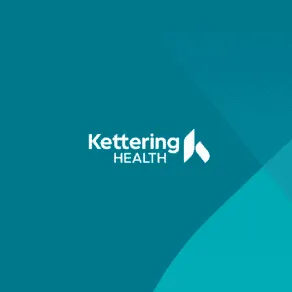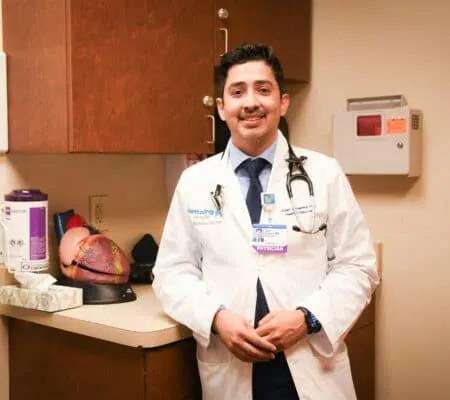Kettering Health’s specialized heart-care team devotes itself to treating heart valve disease with the latest techniques and technology. We’re here to give you our best for your best heart health.
Our heart-clinic team provides personalized, compassionate care for each patient. Our clinic comprises an interdisciplinary team including Interventional Cardiology, Cardiothoracic Surgery, and Cardiac Imaging.
We offer a range of treatment options, including minimally invasive catheter-based therapies, such as Transcatheter Aortic Valve Replacement (TAVR) and MitraClip.
Our team works with patients, families, and referring physicians to develop and implement the most appropriate plan of care.
Diagnosing Heart Valve Disease
The heart is a powerful muscle comprising four valves open and close as blood flows through various chambers. Those valves are the tricuspid, pulmonary, mitral, and aortic. These valves can become narrowed (stenosis) or fail to close (regurgitation). The two valves most often affected are the mitral and aortic valves, causing the heart to beat harder. This can lead to long-term complications, such as weakened heart muscle.
Heart valve disease can be caused by many things, such as defects from birth (congenital heart disease), a history of rheumatic fever, a heart attack, and infection. Aging can also elevate the risks of having heart valve disease.
If your physician suspects heart valve disease, you may be referred to our team of experts at the Structural Heart Clinic. Under our care, our team may perform the following procedures to understand better what’s happening in your heart:
- Chest X-ray: These use X-rays and a detector to create a two-dimensional image of the heart, lungs, bones, and other structures within the chest. This test is often used with other exams to help your doctor confirm a diagnosis.
- CT scan of the chest: This diagnostic exam uses X-rays to generate three-dimensional images of the heart, organs, and other tissues within the body.
- Cardiac magnetic resonance imaging (MRI): These use a magnetic field and radio waves to obtain 3D images of the heart. This test is used to evaluate the anatomy and function of the heart and is helpful in patients with suspected congenital heart disease. Unlike X-rays, cardiac MRIs do not use ionizing radiation.
- Echocardiogram: Also known as an echo, an echocardiogram is an ultrasound procedure that utilizes sound waves to create images of your heart. This test allows your doctor to see the size, shape, heart valve movement, heart chambers and pumping action of the heart.
- Exercise treadmill test (non-imaging): This is an exercise test that monitors the heart’s rate and rhythm while you walk on a treadmill. During exercise treadmill testing, your heart rhythm, heart rate, and blood pressure are monitored to identify possible coronary artery disease, and abnormal heart rhythms. It will also determine the effectiveness of your heart treatment plan or assist your doctor in developing a safe and adequate exercise plan for you.
- Heart catheterization: Cardiac or heart catheterization is a medical procedure that cardiologists use to evaluate heart function and diagnose cardiovascular conditions. During a heart catheterization procedure, a long, narrow plastic tube (catheter) is inserted in an artery, either in the groin or the wrist. Pictures of the heart’s arteries are made with the use of X-ray and the injection of X-ray dye into the arteries. If a blockage is found, intervention is needed.
- Multi-gated acquisition (MUGA): This is a nuclear medicine scan that measures the flow of blood through the heart. The test shows how much blood is pumped through the ventricles with each heartbeat. The MUGA scan helps show abnormalities in the size and function of the ventricles.
- Transesophageal echocardiogram (TEE): This type of echo uses a long, thin tube called an endoscope to guide an ultrasound transducer down the esophagus. It allows your physician to see pictures of the heart without the ribs and lungs in the way. A TEE is done when your physician needs a closer look at your heart or does not have enough information from a regular echo.
Treatment
After diagnosis, our Structural Heart Team at Kettering Health can begin to assess the severity of your valve disease. Treatment of your valve disease depends on how far the disease has progressed. If your disease is mild, medication may be prescribed to regulate your heart rate and prevent blood clots. However, if the disease persists or worsens, the following options are available to repair or replace your heart valves.
- Transcatheter aortic valve repair (TAVR): This is a non-surgical, less invasive means of aortic valve repair for those with severe aortic stenosis who are high risk or too sick for open heart surgery. During TAVR, an interventional cardiologist will insert a hollow tube called a sheath into an artery in your leg. Your new valve, attached to a catheter, will be inserted through this sheath and guided to your diseased valve. The balloon on this catheter will be filled with fluid, expanding your new valve, and pushing aside the leaflets of the diseased valve. The balloon will be deflated and the catheter removed, leaving your brand-new valve permanently placed.
- Balloon valvuloplasty: Like TAVR, this is a non-surgical intervention used to reduce aortic valve stenosis—the narrowing of the aortic valve. The same procedural steps as the TAVR are performed, but unlike TAVR, a new valve is not placed. In this procedure, a balloon is advanced to your diseased valve, inflated to stretch the valve open, and removed with nothing left behind. Doing this should allow the aortic valve to open and close more freely.
- Heart valve repairs: Based on the patient’s medical condition, some valves can be repaired. During this surgical procedure, the leaflets of the valve can be cut down to ensure proper closure. A ring can be sewn around the outside of the valve opening to provide more support or to narrow a dilated valve, repairing the chords that provide structural support for a weakened valve.
- Heart valve replacement: If a valve cannot be repaired, it is surgically replaced with either a mechanical or biological valve. The diseased valve is cut out, and the new valve is sewn in while the patient is on a heart–lung bypass machine. Mechanical valves are made of plastic, carbon, or metal, and they last a long time. Mechanical valves require the patient to use blood thinning medications to prevent clotting. Biological valves are made from animal tissue or from human-donated heart tissue and may need to be replaced every 10 years or so. Biological valve patients do not need to use blood thinning medications.
- Mitral valve clipping: This is a non-surgical way to reduce mitral valve regurgitation, or the backward flow of blood. An interventional cardiologist will insert a hollow tube (a sheath) into a vein in your leg. A catheter is then advanced to the right side of your heart. Using echocardiography, the interventional cardiologist will guide this catheter to the left side of your heart using a technique called transseptal puncture. This catheter will then be advanced through the mitral valve. A clip is then used to grasp the two leaflets of your mitral valve. Once placement is confirmed via echocardiography, these clips will be deployed and permanently remain attached to the mitral valve to reduce regurgitation.
Call the Structural Heart Clinic at Kettering Health Main Campus (937) 395-6023.
Treatments
- Balloon Valvuloplasty
- Heart Valve Clipping
- Heart Valve Repairs
- Heart Valve Replacement
- Transcatheter Aortic Valve Replacement





